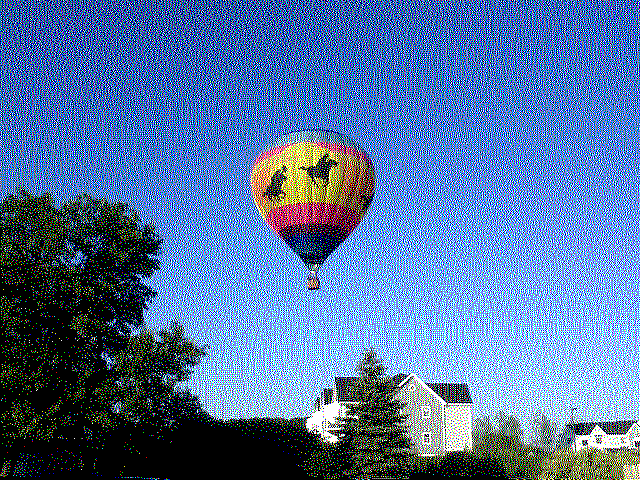Difference between revisions of "Color palettes"
(→RGB) |
|||
| Line 2: | Line 2: | ||
==RGB== | ==RGB== | ||
| − | In the early days of color graphics, RGB was actually pretty rare, but as computers pushed RGB on their monitors, they quickly became the predominant color system in computers and now, most other forms of color display. Here is an image | + | In the early days of color graphics, RGB was actually pretty rare, but as computers pushed RGB on their monitors, they quickly became the predominant color system in computers and now, most other forms of color display. Here is an image using 24-bit RGB color (16,777,216 colors) as a reference for the one-byte palettes below. |
[[Image:Color Palette - RGB - Test.png]] | [[Image:Color Palette - RGB - Test.png]] | ||
| − | === | + | ===R1-G1-B1, 3-bit, 8 Colors=== |
[[Image:Color Palette - 3-Bit Color (1-1-1).png|thumb|128x128px|1 - Red, 1 - Green, 1 - Blue.]] | [[Image:Color Palette - 3-Bit Color (1-1-1).png|thumb|128x128px|1 - Red, 1 - Green, 1 - Blue.]] | ||
| − | + | RGB 3-bit uses one bit for red, one for green, and one for blue which yields a total of 8 colors. Each hue's intensity is either on or off (0 or 255). Graphic displays which use binary LEDs use a system similar to this where a series of red, green, and blue LED are placed next to each other in tandem, and are turned on or off to simulate other colors when viewed at a distance. The limited color palette produces especially grainy results. | |
[[Image:Color Palette - 3-Bit Color (1-1-1) - Example.png]]<br clear="all" /> | [[Image:Color Palette - 3-Bit Color (1-1-1) - Example.png]]<br clear="all" /> | ||
| − | === | + | ===R4-G4-B4, 6-bit, 64 Colors=== |
| − | === | + | ===R8-G8-B4, 8-bit, 256 Colors=== |
[[Image:Color Palette - 8-Bit Color (8-8-4).png|thumb|128x128px|8 - Red, 8 - Green, 4 - Blue.]] | [[Image:Color Palette - 8-Bit Color (8-8-4).png|thumb|128x128px|8 - Red, 8 - Green, 4 - Blue.]] | ||
| Line 22: | Line 22: | ||
[[Image:Color Palette - 8-Bit Color (8-8-4) - Example.png]]<br clear="all" /> | [[Image:Color Palette - 8-Bit Color (8-8-4) - Example.png]]<br clear="all" /> | ||
| − | === | + | ===R8-G4-B8, 8-bit, 256 Colors=== |
[[Image:Color Palette - 8-Bit Color (8-4-8).png|thumb|128x128px|8 - Red, 4 - Green, 8 - Blue.]] | [[Image:Color Palette - 8-Bit Color (8-4-8).png|thumb|128x128px|8 - Red, 4 - Green, 8 - Blue.]] | ||
| Line 30: | Line 30: | ||
<br clear="all" /> | <br clear="all" /> | ||
| − | === | + | ===R4-G8-B8, 8-bit, 256 Colors=== |
[[Image:Color Palette - 8-Bit Color (4-8-8).png|thumb|128x128px|4 - Red, 8 - Green, 8 - Blue.]] | [[Image:Color Palette - 8-Bit Color (4-8-8).png|thumb|128x128px|4 - Red, 8 - Green, 8 - Blue.]] | ||
Revision as of 12:47, 20 March 2018
A Single Byte Color Palette is a color palette that can be defined using eight or fewer bits. There are many different algorithms used to encode an entire color palette into a single byte and quickly get the results.
Contents
RGB
In the early days of color graphics, RGB was actually pretty rare, but as computers pushed RGB on their monitors, they quickly became the predominant color system in computers and now, most other forms of color display. Here is an image using 24-bit RGB color (16,777,216 colors) as a reference for the one-byte palettes below.
R1-G1-B1, 3-bit, 8 Colors
RGB 3-bit uses one bit for red, one for green, and one for blue which yields a total of 8 colors. Each hue's intensity is either on or off (0 or 255). Graphic displays which use binary LEDs use a system similar to this where a series of red, green, and blue LED are placed next to each other in tandem, and are turned on or off to simulate other colors when viewed at a distance. The limited color palette produces especially grainy results.
R4-G4-B4, 6-bit, 64 Colors
R8-G8-B4, 8-bit, 256 Colors
This system separates the bits in a byte into three sections, 3 are used for the red intensity, 3 for the green intensity, and 2 for the blue intensity. This results in 8 levels of red, 8 of green, and 4 of blue. This is often the optimal system because the human eye is better at discerning between different intensities of red and green compared to blue.
R8-G4-B8, 8-bit, 256 Colors
This system separates the bits in a byte into three sections, 3 are used for the red intensity, 2 for the green intensity, and 3 for the blue intensity. This results in 8 levels of red, 4 of green, and 8 of blue. This is often the optimal system because the human eye is better at discerning between different intensities of red and green compared to blue.
R4-G8-B8, 8-bit, 256 Colors
This system separates the bits in a byte into three sections, 3 are used for the red intensity, 3 for the green intensity, and 2 for the blue intensity. This results in 4 levels of red, 8 of green, and 8 of blue. This is often the optimal system because the human eye is better at discerning between different intensities of red and green compared to blue.







